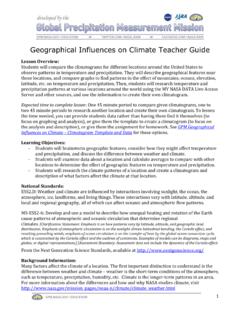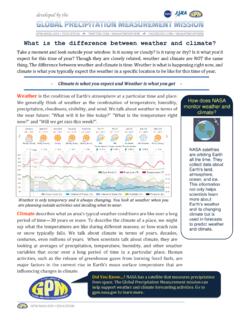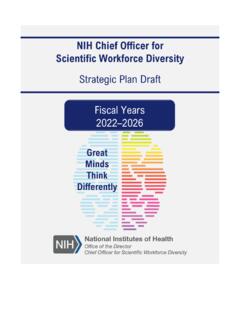Transcription of Climate Change Inquiry Labs - Teacher Guide
1 Climate Change Inquiry Labs - Teacher Guide Lesson Overview: Students will conduct labs investigating the drivers of Climate Change , including adding carbon dioxide and other greenhouse gases to the atmosphere, sea level rise, and the effect of decreasing sea ice on temperatures. They will become experts on one of these areas, conduct their own experiments and connect them to real-world data, and then make posters to present their findings to the class. Expected time to complete: One 45-60 minute period to complete labs, one to two 45 minute periods to create and present posters (depending on whether posters are completed in class or as homework, and if presentations are done as a gallery walk or orally). This lesson plan can be used as an introduction, supplement or substitute for the GPM Climate Change Online Interactive Lesson.
2 Learning Objectives: Students will investigate aspects of Climate Change 's drivers by conducting experiments and reporting back on what they have learned. National Standards: Human activities, such as the release of carbon dioxide from burning fossil fuels, are major factors in global warming. Reducing the level of Climate Change and reducing human vulnerability to whatever Climate changes do occur depend on the understanding of Climate science, engineering capabilities, and other kinds of knowledge, such as understanding of human behavior and on applying that knowledge wisely in decisions and activities. MS-ESS3-5. Ask questions to clarify evidence of the factors that have caused the rise in global temperatures over the past century. [Clarification Statement: Examples of factors include human activities (such as fossil fuel combustion, cement production, and agricultural activity) and natural processes (such as changes in incoming solar radiation or volcanic activity).]
3 Examples of evidence can include tables, graphs, and maps of global and regional temperatures, atmospheric levels of gases such as carbon dioxide and methane, and the rates of human activities. Emphasis is on the major role that human activities play in causing the rise in global temperatures.]. Background Information: The Earth's Climate has changed throughout history. Just in the last 650,000 years there have been seven cycles of glacial advance and retreat, with the abrupt end of the last ice age about 7,000 years ago marking the beginning of the modern Climate era and of human civilization. Most of these Climate changes are attributed to very small variations in Earth's orbit that Change the amount of solar energy our planet receives. The current warming trend is of particular significance because most of it is very likely human- induced and proceeding at a rate that is unprecedented in the past 1,300 years.
4 1. Earth-orbiting satellites and other technological advances have enabled scientists to see the big picture, collecting many different types of information about our planet and its Climate on a global scale. Studying these Climate data collected over many years reveal the signals of a changing Climate .. From NASA is monitoring five main vital signs of the planet: carbon dioxide, global temperature, arctic sea ice, land ice and sea level. The investigations in this lesson will give students hands-on experience with models of these changes. For a more computer-based exploration of these vital signs, as a supplement or substitute for this lesson, see GPM Climate Change Online Interactive Lesson. For a kid-friendly look at Climate Change , see For more about sea ice, see Materials: Melting Ice and Sea Level Rise Carbon Dioxide and Air Sea Ice and Ocean Temperature (per group) Temperature (per group) (per group).
5 Large graduated cylinders (2) beakers or clear plastic flat containers (2) - plastic water containers (2) bins, cut open cardboard ice cubes plastic wrap cartons, or something similar funnel rubber band or string thermometers or temperature thermometers or temperature probes (2). probes (2) tape tape towels for insulation (optional, but recommended). heat lamp and bulb graduated cylinder or measuring cup water aluminum foil (to represent sea ice). Computers, or printouts of activities to complete while labs run Poster paper and markers (or computers to create digital presentations, if preferred). Engage: Use GPM Climate Change Inquiry Labs Presentation to show students a cartoon about Santa reading a newspaper about global warming and commenting about giving out lumps of coal (slide 3).
6 Use it as a starting point to discuss what students have heard about Climate Change and global warming. Next, show students a graph of atmospheric carbon dioxide measured at Mauna Loa Observatory in Hawaii (slide 4) and ask them what they observe about the graph and what might have caused the Change seen. Students will probably be able to make the connection between the increasing use of cars, as well as increasing demands for electricity, often produced by coal- burning power plants. Carbon dioxide is the greenhouse gas on which humans have the most impact. While the data in the graph is from ground sources, NASA also monitors Climate indicators from space. 2. The heat-trapping nature of carbon dioxide and other gases was demonstrated in the mid-19th century.
7 Their ability to affect the transfer of infrared energy through the atmosphere is the scientific basis of many instruments flown by NASA. Increased levels of greenhouse gases must cause the Earth to warm in response.. From Explore: Divide students into groups, which will become experts on one lab investigation and share results with the larger group (slide 5-6). See the Teacher Notes section later in this document for tips on the set-up and implementation of the labs. In addition, these labs could serve as a hands-on introduction to the GPM Climate Change Online Interactive Lesson the combination of experimentation and computer research could then be presented in the posters. Melting Ice and Sea Level Rise (adapted from ). Students will investigate whether melting land ice or sea ice will have a greater impact on sea level rise.
8 For detailed instructions, see GPM Climate Change Melting Ice and Sea Level Rise Lab. While the experiment runs, students can explore interactive maps (or printouts) of areas that might be affected by sea level rise while experiment runs. ( ). Carbon Dioxide and Air Temperature (adapted from Glory and Global Warming Experiment and Astro-Venture Greenhouse Gases Modeling Activity, ). Students will compare the temperature increase in two containers one simulating greenhouse gases, one without. (NOTE: The plastic wrap is representing carbon dioxide in the model used for the experiment. Greenhouse gases don't hold in heat exactly the same way as the plastic wrap, but using various methods of adding actual carbon dioxide doesn't produce consistent results in the small scale.)
9 For detailed instructions, see GPM Climate Change Carbon Dioxide and Air Temperature Lab. While the experiment runs, students can explore their own carbon footprint on two different websites, and Sea Ice and Ocean Temperature. Students will compare the water temperature in two bins one representing open ocean after all the sea ice has melted, one partially blocked by foil, representing the reflective sea ice. For detailed instructions, see GPM Climate Change Sea Ice and Ocean Temperature Lab. While the experiment runs, students can read information about sea ice from the National Snow and Ice Data Center ( ) and explore an interactive map of predicted arctic sea ice ( interactive) and learn about Inuit terms and knowledge of sea ice ( ). You will likely need to duplicate the labs and have several groups complete the same experiment, depending on your class size.
10 3. Explain: After the experiments are complete, students will make posters outlining the problem they have researched including data from their experiment, how it relates to the real world, as well as relevant data from NASA or other sources. You could have each group create a poster, or have individuals complete their own, in class or as homework. If computers are available, electronic presentations could be created instead of posters. Students should use the rubric (slide 7 and at the end of this document) to Guide them as they create the posters. The GPM Climate Change Inquiry Labs Student Capture Sheet has space for students to make notes about each of the three topics when they are presented. Depending on the time you have available, you could have each group do an oral presentation to the class, divide students into smaller groups (each with a student who completed each experiment) to share the information as experts, or display the posters for a gallery walk.










